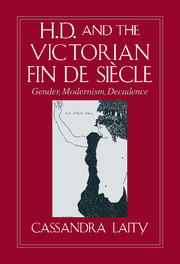Book contents
- Frontmatter
- Contents
- Acknowledgments
- Introduction: Dramatis Personae: The Aesthete Androgyne and the Femme Fatale
- 1 The Rhetoric of Anti-Romanticism: Gendered Genealogies of Male Modernism
- 2 H.D.'s Early Decadent Masks and Images: HER; Sea Garden
- The Aesthete Androgyne
- The Femme Fatale
- 5 Toward a Revised Myth of Origins: From the Diaphanous Androgyne to the Abject Femme Fatale
- 6 From Agon to “Héros Fatale”: Pre-Raphaelite Transformations of Male Modernism/Modernity
- 7 Feminine Abjection and Trilogy
- Postscript
- Notes
- Index
- CAMBRIDGE STUDIES IN AMERICAN LITERATURE AND CULTURE
7 - Feminine Abjection and Trilogy
Published online by Cambridge University Press: 06 January 2010
- Frontmatter
- Contents
- Acknowledgments
- Introduction: Dramatis Personae: The Aesthete Androgyne and the Femme Fatale
- 1 The Rhetoric of Anti-Romanticism: Gendered Genealogies of Male Modernism
- 2 H.D.'s Early Decadent Masks and Images: HER; Sea Garden
- The Aesthete Androgyne
- The Femme Fatale
- 5 Toward a Revised Myth of Origins: From the Diaphanous Androgyne to the Abject Femme Fatale
- 6 From Agon to “Héros Fatale”: Pre-Raphaelite Transformations of Male Modernism/Modernity
- 7 Feminine Abjection and Trilogy
- Postscript
- Notes
- Index
- CAMBRIDGE STUDIES IN AMERICAN LITERATURE AND CULTURE
Summary
Recent postmodernist critiques of Yeats, Eliot, and others have explored male modernist deployments of the abject body in an attempt to reclaim poetic modernism from the closed conservative discourse of New Criticism. In The Failure of Modernism, Andrew Ross links the modernist “desire to reject old languages and create new ones” with the “response to the abject” he perceives in modern writers such as Pound, Joyce, Stein, Williams, and others. “Governed by a formal imperative to ‘make it new,’” these artists “confront the body in new ways” (Ross 87). Enumerating T. S. Eliot's abounding poetic incidences of corpses, “female smells in shuttered rooms,” and “subtle effluence[s]” and other bodily wastes, Ross claims that he could write an additional chapter on Eliot's female abjection alone (Ross 81). Similarly, Maud Ellmann (The Poetics of Impersonality) jubilantly tracks through the “wastes” of The Waste Land, cataloguing all the half-dead, liminal, dejected bodies that swarm through the poem. If waste is what a culture throws away in order to define itself, then the “dead” literary “echoes,” cast-off butt-ends of the city's days and ways, and the female abjection of “abortions, broken fingernails, and carious teeth,” spread like “contagion” through the poem to “the collapse of boundaries … be they sexual, national, linguistic or authorial” (Maud Ellmann 93, 94). Despite the postmodernist methodology, however, these skillful critiques do not argue that in Eliot's poetry, at least, such decentering activity is liberating or revolutionary.
- Type
- Chapter
- Information
- H. D. and the Victorian Fin de SiècleGender, Modernism, Decadence, pp. 170 - 184Publisher: Cambridge University PressPrint publication year: 1996



